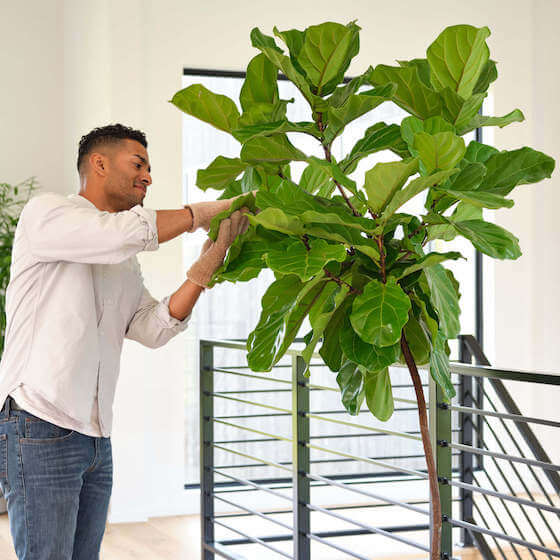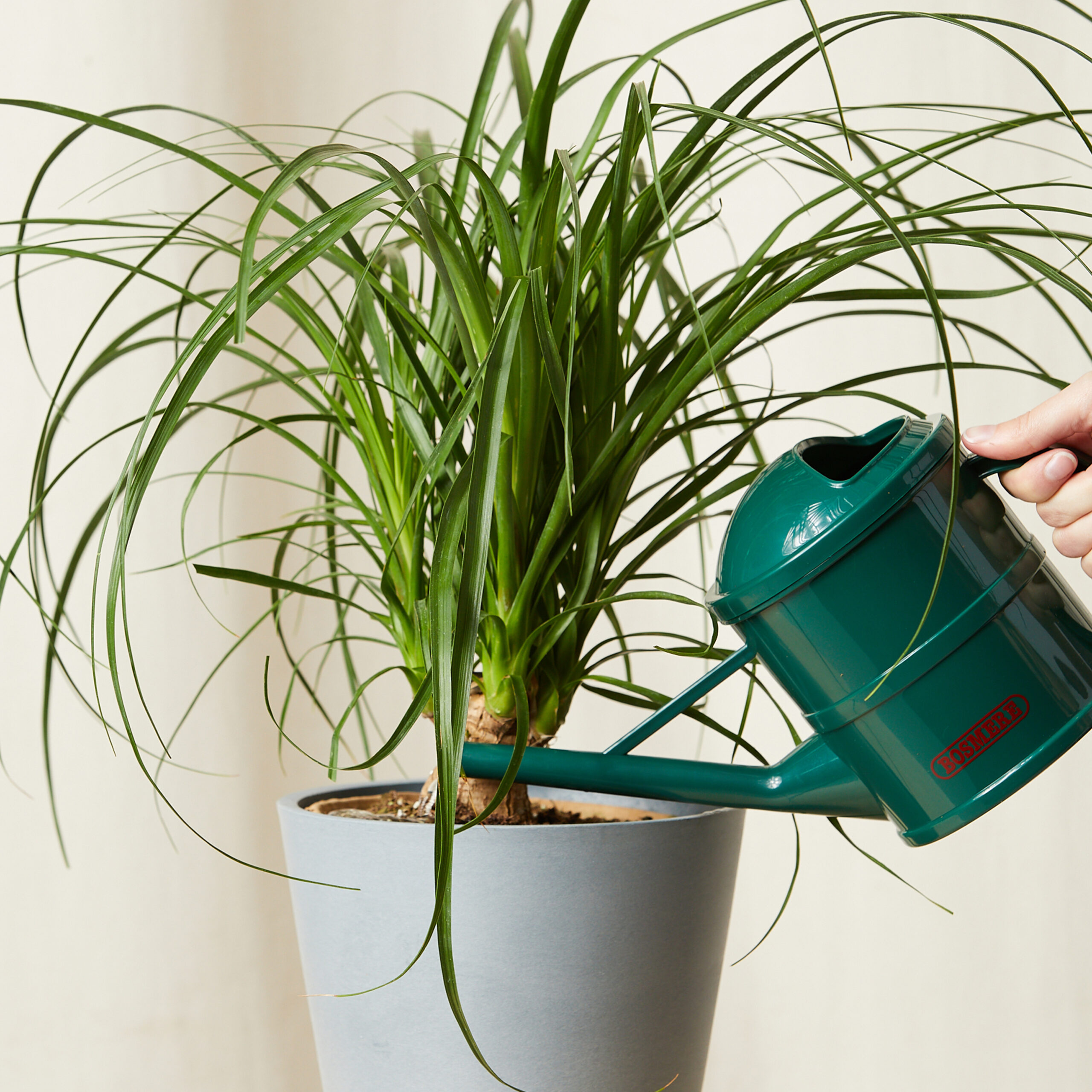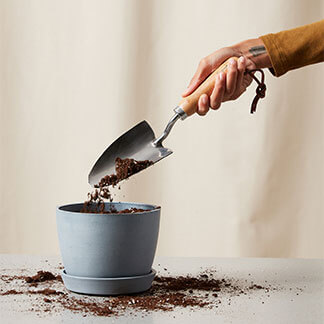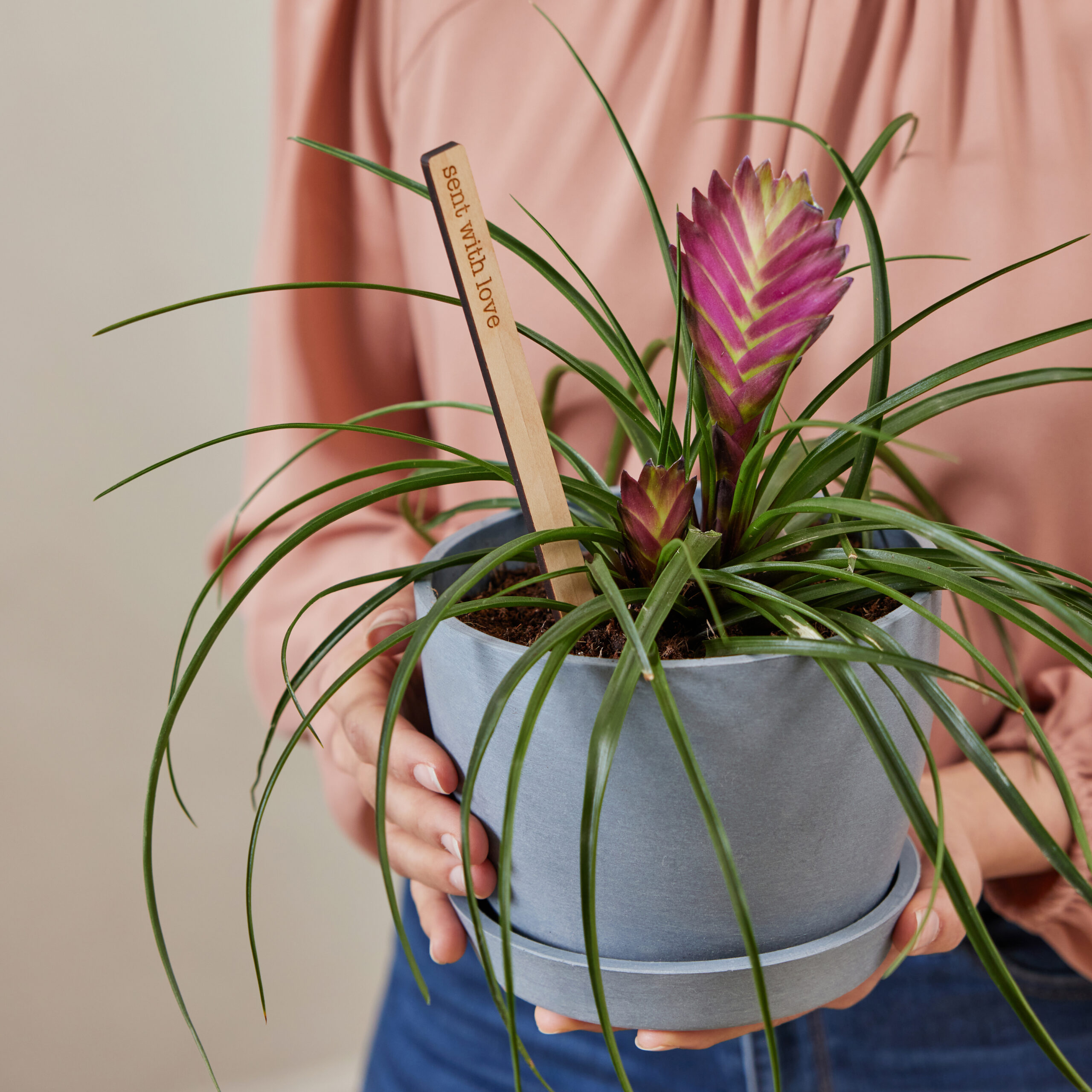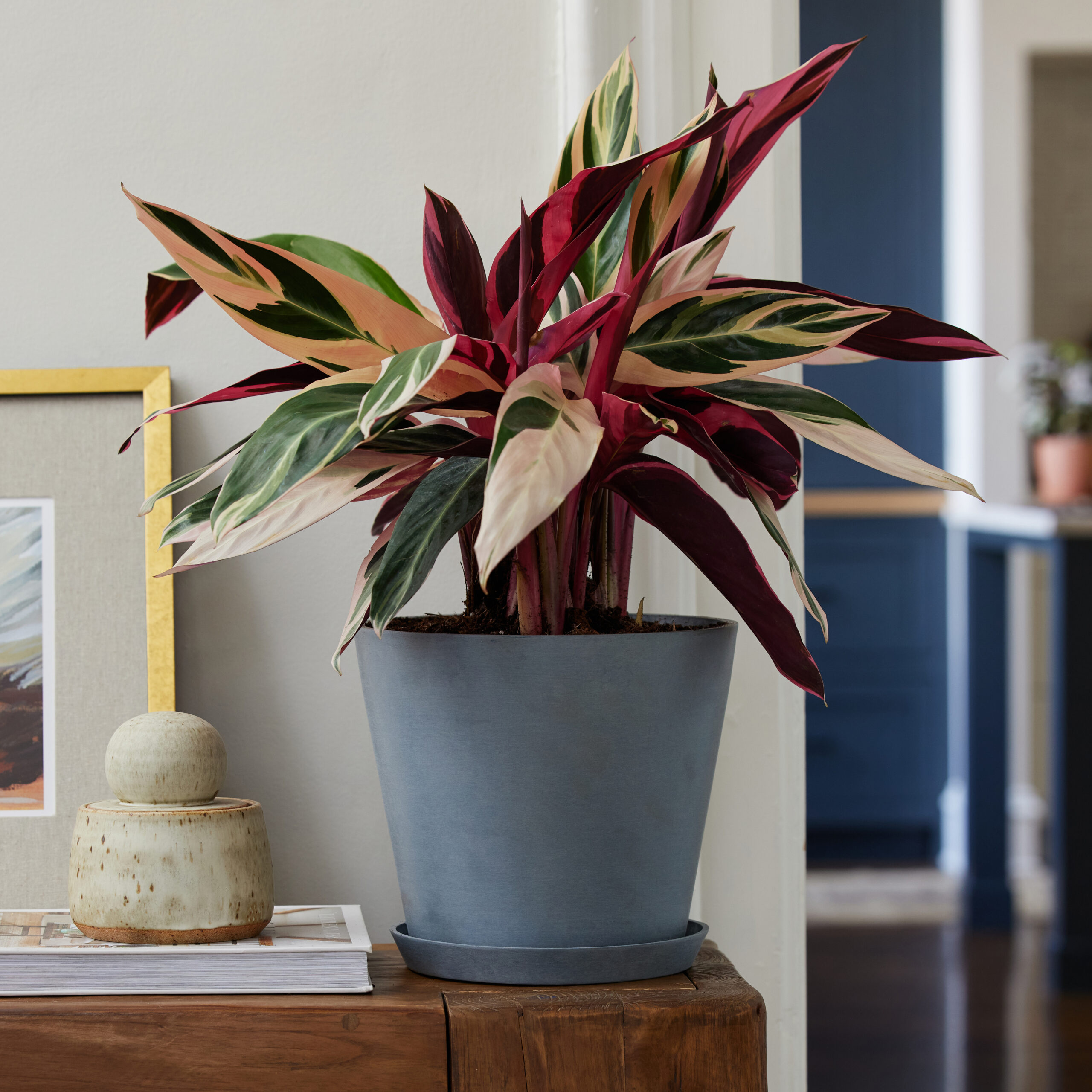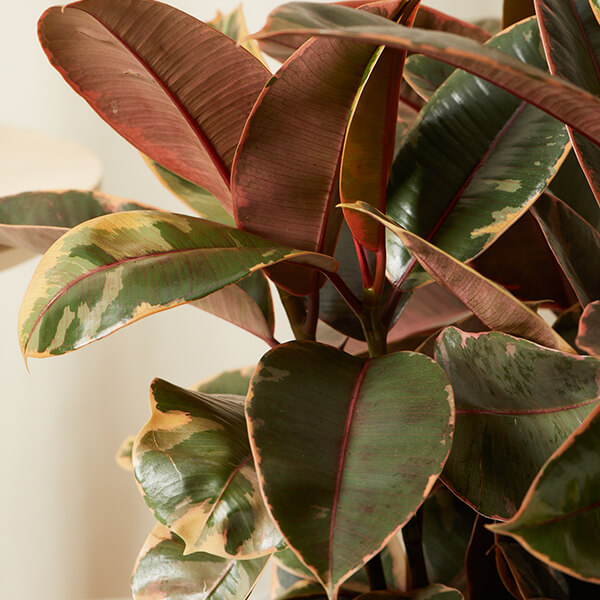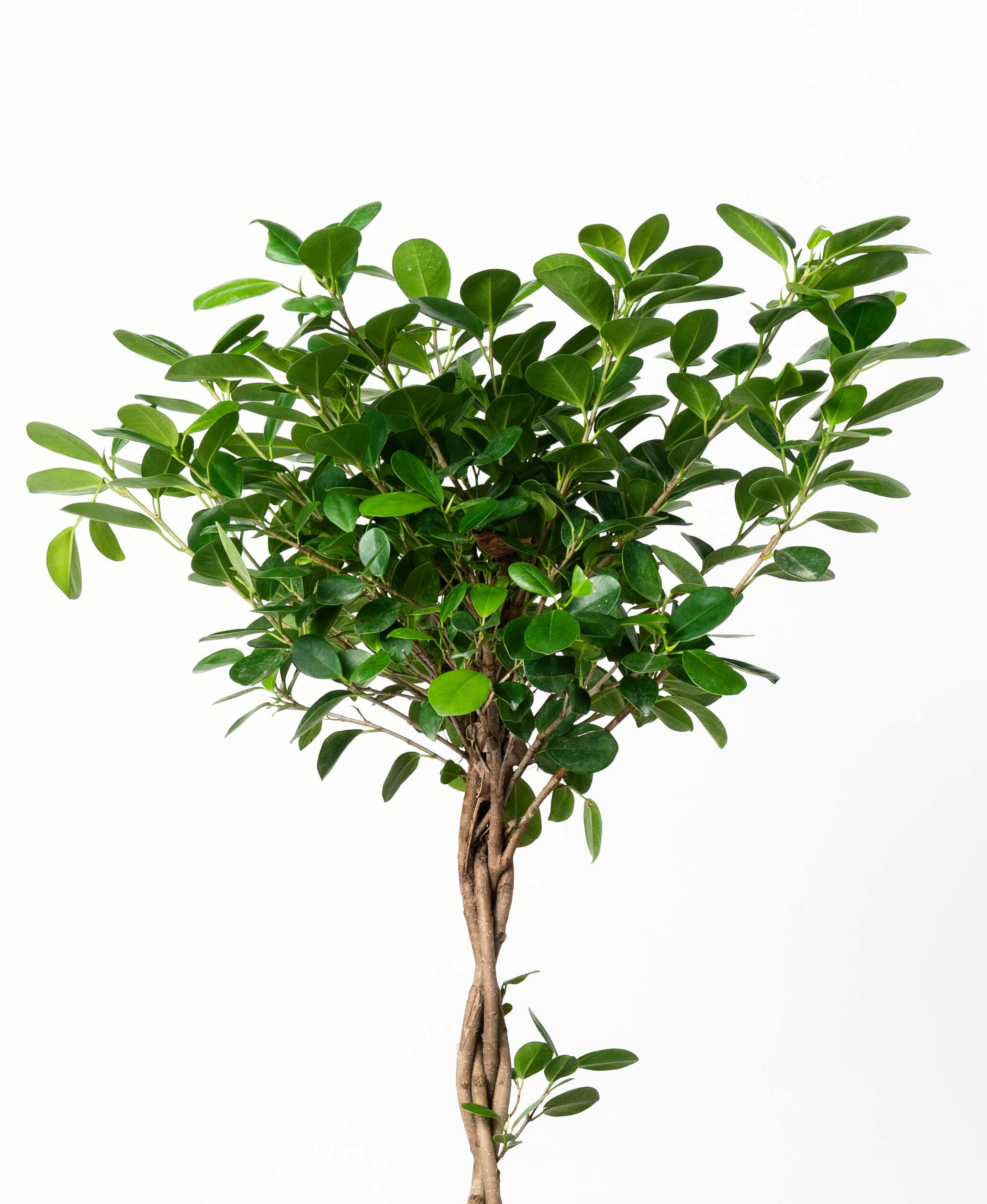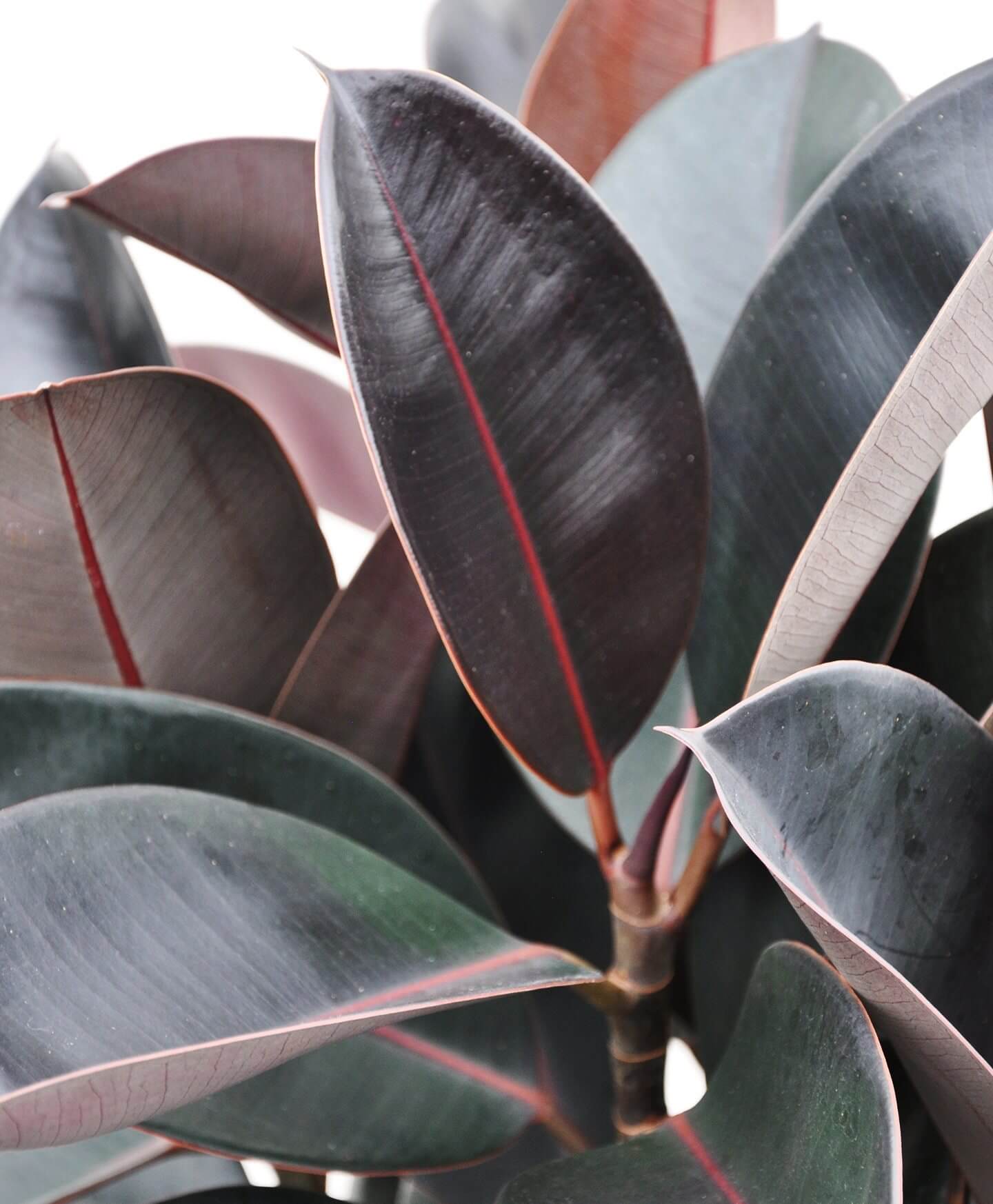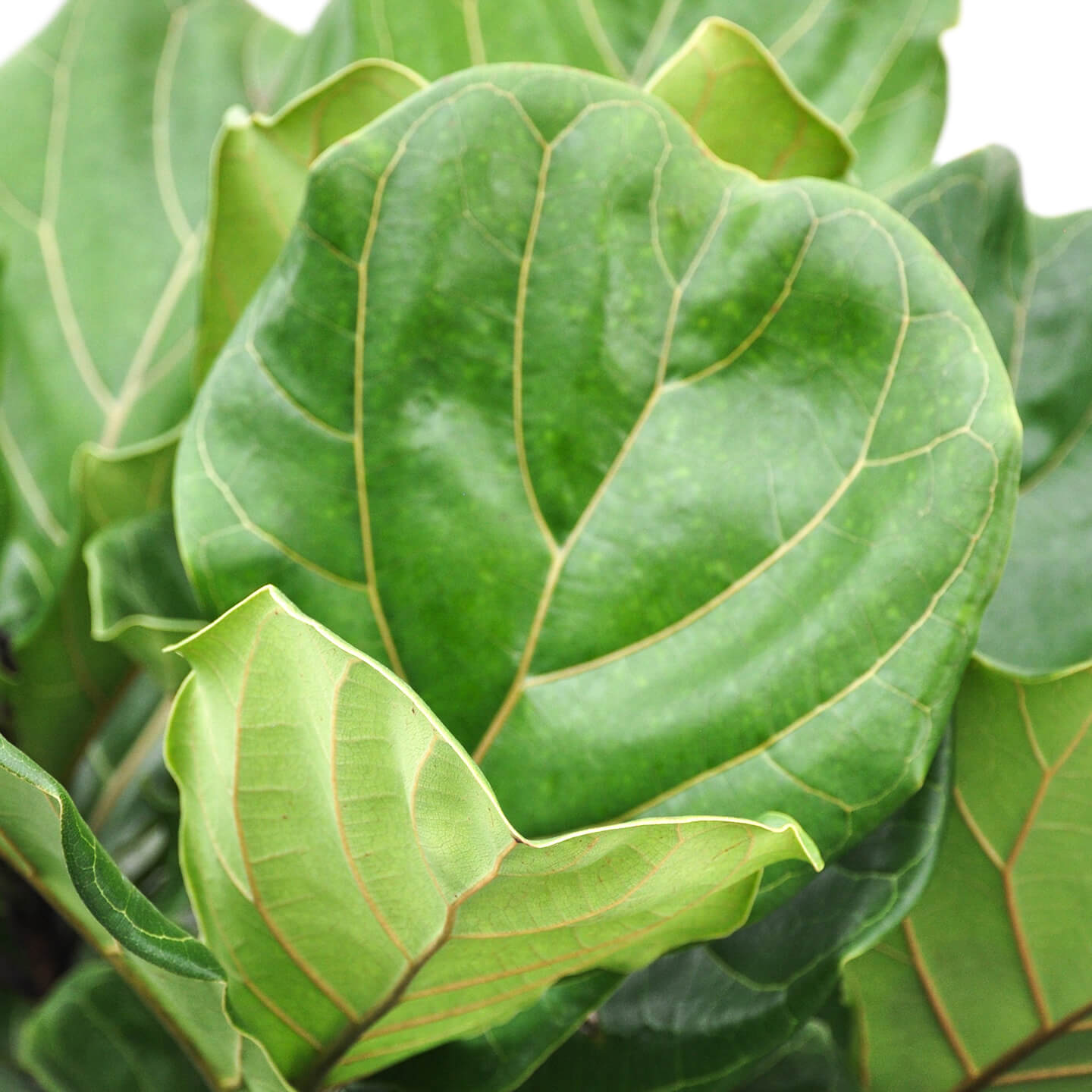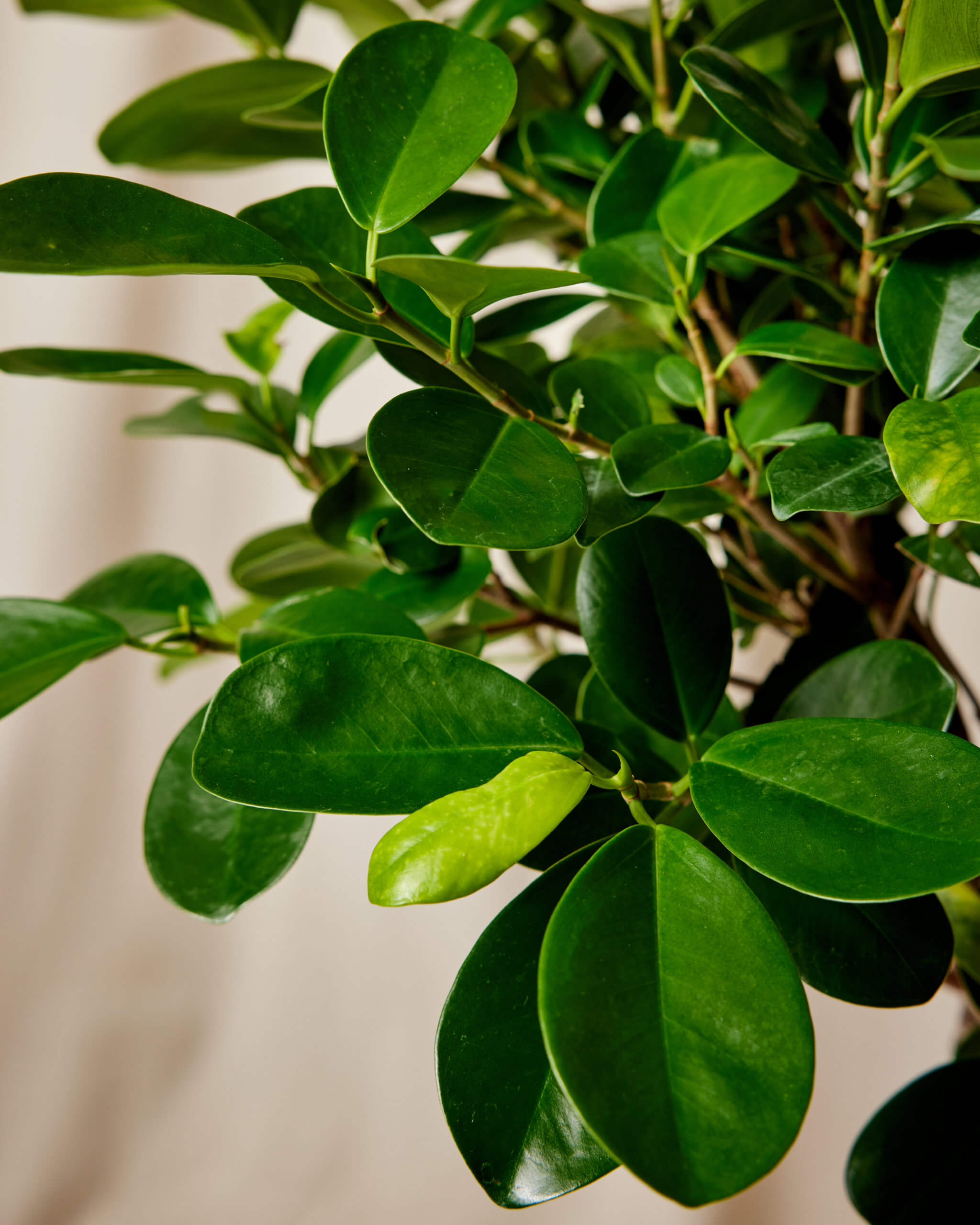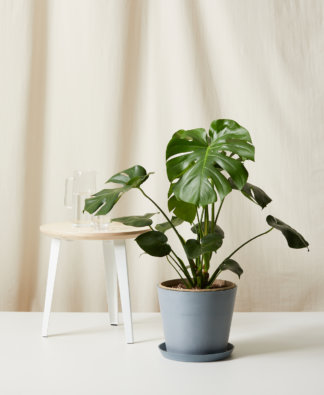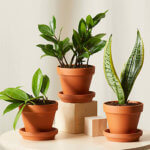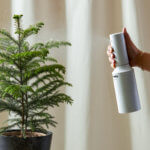How to care for your Ficus
Use these instructions to care for a Ficus. This guide will tell you how to water a Ficus; its light, temperature, humidity preferences and any additional care it might need to help it grow.
Burgundy Rubber Tree
The burgundy rubber plant enjoys full sunlight the most but will also thrive in bright, indirect exposure. Its hardy leaves prove to be durable against the sun’s rays. However, inadequate lighting will stunt your plant’s growth. If needed, you can place a grow light nearby.
The roots of your burgundy rubber plant do not like to sit in water. So allowing the soil to dry completely in between waterings is your best option. When you do water your plant, make sure the water drains from the holes at the bottom of the pot and empty all liquid from the saucer.
Your average indoor humidity level also works well for this plant, but if the air is too dry, you might turn on a humidifier for a short while or use a pebble tray.
Average indoor temperatures work well for your burgundy rubber plant as well, but you might still aim for 60℉ to 80℉. And don’t forget to keep your plant away from cold drafts and vents.
During the spring and summer months, your burgundy rubber plant will enjoy a feeding once or twice a month. A balanced, houseplant formula diluted at half strength provides all the nutrients it needs.
The Burgundy Rubber Plant is toxic to both pets and humans. Coming in contact with its sap can cause skin irritation or mouth irritation for pets who chew on the stem. If ingested, this plant causes stomach irritation or nausea and vomiting.
Rubber Trees are sensitive to being moved. If you have to move your plant to a drastically different spot, do so gradually. Any sudden changes can cause leaves to drop. When pruning your plant, be careful of the milky latex substance that may leak out where cuts have occurred—this is a mildly toxic irritant. If you get the sap on your hands or skin, wash with warm water and soap immediately.
Ficus Alii
Place your Ficus Alii in bright indirect or filtered light. Avoid bright direct light as it will burn the leaves and cause them to drop.
Water with room-temperature water once the soil dries 50-75% down. Water thoroughly until water flows into the saucer, then pour out any excess.
Your Ficus tree will do well in average humidity environments but will appreciate regular misting.
Your Ficus Alii will thrive in average temperatures of 60-75 degrees.
Fertilize your Ficus tree every month in late spring and summer with a general-purpose fertilizer diluted to half strength. You will see new leaves appear and branches grow during this time. No fertilizer is necessary during the winter when plant growth naturally slows.
Ficus Alii leaves are mildly toxic to pets and humans. Typically, ingestion will cause mouth and stomach irritation with possible vomiting.
Ficus are sensitive to changes in their environment. They react to these changes by dropping leaves. If you have just moved your Ficus to a new location, expect the leaves to drop. The leaves will begin growing again when the plant adjusts to its new location. If it has not been moved, it could be the result of a change in lighting conditions as the seasons change. Or, it may be reacting to an increase or decrease in its watering frequency.
Ficus Altissima
Keep your ficus in bright indirect light. This plant will not tolerate low light and variegation will fade. Close to an eastern window or just a few feet back from a southern or western window is ideal.
Water when 50-75% of the soil volume is dry. Always water thoroughly until it flows out of the drainage hole to encourage a healthy root system. Discard any excess water in the saucer.
The Ficus Altissima does fine in average household humidity, but won’t mind an extra humidity boost.
Your Ficus Altissima enjoys average room temperatures of 60-80°F. Avoid drafty areas or open vents.
For best results, feed your ficus once a month from spring through summer with a general houseplant fertilizer for indoor plants.
Your Ficus is toxic to humans and pets if ingested.
When pruning your plant, make sure to watch out for the milky latex substance that could leak out where cuts have occurred—this is a mildly toxic irritant. If you get the sap on your hands or skin, wash with warm water and soap immediately.
Ficus Audrey
Your Ficus prefers bright indirect light. Direct sun may burn the leaves and cause them to drop.
Water your Ficus Audrey when the top 50-75% of the soil is dry. Water until liquid flows through the drainage hole at the bottom of the pot and discard any water that has accumulated in the saucer.
Your Ficus Audrey will thrive in average household humidity but will appreciate a boost in humidity from time to time. Regular misting, using a pebble tray, or placing a humidifier nearby are great ways to increase humidity for your Ficus.
Your Ficus Audrey enjoys average room temperatures of 60-80 degrees. Avoid temperatures below 55 degrees, sudden temperature drops, or cold drafts.
For best results, feed your Ficus once a month from spring through summer with a general houseplant fertilizer diluted to half the recommended strength.
Ficus leaves are mildly toxic to humans and pets. Typically, ingestion will cause mouth and stomach irritation and possible vomiting.
Ficus plants are sensitive to being moved. If you have to move your plant around, do so gradually. Any sudden changes can cause leaves to drop. When pruning your plant, be careful of the milky latex substance that may leak out where cuts have occurred—this is a mildly toxic irritant. If you get the sap on your hands or skin, wash with warm water and soap immediately.
Ficus Benjamina
Place your Ficus Benjamina in bright indirect or filtered light. Avoid bright direct light as it can burn the leaves and cause them to drop.
Allow 75% of the soil to dry between watering. When watering, water thoroughly until water flows into the saucer, then pour out any excess.
Your Ficus tree will do well in average humidity environments but will appreciate regular misting.
Your Ficus Benjamina will thrive in average temperatures of 60-75 degrees.
Fertilize your Ficus tree once a month in late spring and summer with a general-purpose fertilizer diluted to half strength. You will see new growth during this time. No fertilizer is necessary during the winter when plant growth naturally slows.
Ficus Benjamina leaves are mildly toxic to pets and humans. Typically, ingestion will cause mouth and stomach irritation with possible vomiting.
Ficus are sensitive to changes in their environment. They react to these changes by dropping leaves. If you have just moved your Ficus to a new location, expect some leaves to drop. If it has not been moved, it could be the result of a change in lighting conditions as the seasons change. It may also be reacting to an increase or decrease in its watering frequency.
Ficus Danielle
Your Ficus Danielle prefers very bright indirect light. Too little light can cause slow growth and decline of the plant.
Water when the top 50%-75% of the soil is dry. Water until liquid flows through the drainage hole at the bottom of the pot and discard any water that has accumulated in the saucer.
Your Ficus tree will do well in average humidity environments but will appreciate regular misting.
Your Ficus Danielle will thrive in average temperatures of 60-75°F.
Fertilize your Ficus tree every four weeks in late spring and summer with a general-purpose fertilizer diluted to half strength. You will see new leaves appear and branches grow during this time. No fertilizer is necessary during the winter when plant growth naturally slows.
Ficus Danielle leaves are toxic to humans and pets if ingested.
You can prune your Ficus Danielle during the growing season to keep its classically round shape. When pruning your plant, make sure to watch out for the milky latex substance that could leak out where cuts have occurred–this is a mildly toxic irritant. If you get the sap on your hands or skin, wash with warm water and soap immediately.
Ficus Ginseng
Your Ficus Ginseng will be happiest if placed in a spot where it can receive very bright indirect light. It will not tolerate low light. Direct sun may burn the leaves and cause them to drop.
Water when 50%-75% of the soil volume is dry. Water until liquid flows through the drainage hole at the bottom of the pot and discard any water that has accumulated in the saucer.
Your Ficus prefers a humid environment. Keep a humidifier nearby or create a pebble tray.
Your Ficus prefers temperatures between 60-80°F. Keep your plant away from blowing air or cold drafts, as this could cause leaves to fall off.
Feed once a month during the spring and summer with a general-purpose fertilizer for indoor plants.
This plant is considered toxic to humans and pets if ingested.
Your Ficus Ginseng is a relatively slow-growing plant and won’t need to be repotted very often, only once every 1-3 years. You can prune your Ficus during spring and summer to maintain its small size to reduce the need for repotting.
Ficus Repens Green
Your Ficus Repens Green enjoys bright indirect light. It is best to place this plant near an eastern or western facing window.
Your Ficus does not like to dry out completely–water thoroughly when the top 50-75% of the soil is dry. When watering, water enough so that water flows into the saucer, but never let water sit in the saucer for extended periods of time. This can lead to root rot and the eventual death of your plant.
Your Ficus will do well in average household humidity but will benefit greatly from a humidifier, pebble tray, or frequent misting to boost humidity. Another way to increase relative humidity is to group several humidity-loving plants together in a small area, creating a micro-climate.
Your Ficus likes normal room temperatures between 60-80 degrees. Avoid cold winter drafts and direct airflow from heating vents.
Your Ficus will benefit from regular fertilizing during the spring through fall. Feed with a general houseplant fertilizer diluted to half the recommended strength every month.
Even though mature plants can produce edible fruits, your Ficus Repens excretes a milky sap that is toxic and can cause skin irritation and inflammation. Keep it away from pets and children.
To attain a dramatic and fun look in your home, you can let you Ficus Repens vine up on walls. If you have a textured wall, your Ficus will use its aerial roots to grab on by itself, or you can use hooks to help it vine in the direction that you want. Fun fact: the aerial roots secrete a latex substance to help attach to surfaces. This substance is a skin irritant, so be careful!
Ficus Spire
Place your Ficus Spire in bright indirect or filtered light. Avoid bright direct light as it will burn the leaves and cause them to drop.
Water with room-temperature water once the topsoil 50–75% is dry. Water thoroughly until water flows into the saucer, then pour out any excess.
Your Ficus tree will do well in average humidity environments but will appreciate regular misting.
Your Ficus Spire will thrive in average temperatures of 60-75 degrees.
Fertilize your Ficus tree every month in late spring and summer with a general-purpose fertilizer diluted to half strength. You will see new leaves appear and branches grow during this time. No fertilizer is necessary during the winter when plant growth naturally slows.
Ficus Spire leaves are mildly toxic to pets and humans. Typically, ingestion will cause mouth and stomach irritation with possible vomiting.
Ficus are sensitive to changes in their environment. They react to these changes by dropping leaves. If you have just moved your Ficus to a new location, expect the leaves to drop. The leaves will begin growing again when the plant adjusts to its new location. If it has not been moved, it could be the result of a change in lighting conditions as the seasons change. Or, it may be reacting to an increase or decrease in its watering frequency.
Ficus Tineke
Your Ficus Tineke prefers bright, indirect light. Your plant may lose its beautiful cream variegation on new leaves if it’s not receiving enough light. If you are worried you don’t have enough light for your plant, consider using a grow light.
Water your plant when 50%-75% of the soil volume is dry. Water until liquid flows through the drainage hole at the bottom of the pot and discard any water that has accumulated in the saucer.
Your Ficus Tineke will do great in average household humidity but will appreciate a boost in humidity from time to time. Regular misting, using a pebble tray, or placing a humidifier nearby are great ways to increase humidity for your Ficus.
Your Ficus Tineke enjoys average room temperatures of 60-80°F. Avoid temperatures below 55°F, sudden temperature drops, or cold drafts.
For best results, feed your Ficus Tineke once a month from spring through summer with a general houseplant fertilizer diluted to half the recommended strength. No fertilizer is needed in the fall and winter months when growth naturally slows.
This plant is mildly toxic to humans and pets. Typically, ingestion will cause mouth and stomach irritation and possible vomiting. The sap can cause skin irritation.
Your Ficus will excrete a milky latex sap where cuts have occurred. This substance can irritate sensitive skin and stain clothing or other items. Take precautions to protect your hands and work area when pruning this plant, and wash with soap and water if contact does occur.
Ficus Umbellata
Your Ficus Umbellata requires bright indirect light. Rotate the pot regularly to encourage even, balanced growth. It can tolerate a few hours of direct morning sun, but avoid exposing the leaves to the harsh afternoon sun. This plant does not tolerate low light conditions.
Water your Ficus when the top 50% of the soil is dry. Water until liquid flows through the drainage hole at the bottom of the pot and discard any water that has accumulated in the saucer.
As a native to the tropics, Ficus Umbellata appreciates extra humidity. Mist the leaves to increase humidity around your plant, especially in the drier winter months.
The Ficus Umbellata enjoys warmer temperatures between 65-85°F. It will not tolerate cold drafts so make sure you avoid placing your plant in drafty areas.
For best results, feed your plant once during the spring and monthly throughout the summer. A little bit of food will go a long way to encourage growth and root health. No fertilizer is necessary during the winter when plant growth naturally slows.
Ficus leaves are mildly toxic to humans and pets. Typically, ingestion will cause mouth and stomach irritation and possible vomiting.
Large leaves can collect dust. If you notice the leaves are dirty or dusty, wipe them with a damp cloth and gently dry to keep them clean and healthy. Ficus generally do not like to be moved — if necessary to move your plant, be prepared for some leaf drop until it is acclimated again in a few weeks.
Fiddle Leaf Fig
Keep your fiddle leaf fig in bright indirect light. This plant will not tolerate low light, and its leaves will eventually yellow and drop. Close to an eastern window or acclimated to the direct light from a southern window is ideal. Also, you can supplement with a grow light.
Your Fiddle Leaf Fig Plant loves moist soil but not soggy. So you’ll need to water when the top inch of the soil is dry. Always water thoroughly until it flows out of the drainage hole to encourage a healthy root system. Discard any excess water in the saucer.
The fiddle leaf fig does fine in average household humidity, but wouldn’t mind an extra humidity boost. So once in a while, you can place a humidifier in the same room.
Your fiddle leaf fig enjoys average room temperatures of 60-80°F. Avoid drafty areas or open vents as well as any temperature fluctuations.
For best results, feed your plant once during the spring and monthly throughout the summer. Over-fertilizing can cause the fiddle leaf fig to grow leggy and can even kill it. A little bit of food will go a long way to encourage growth and root health. No fertilizer is necessary during the winter when plant growth naturally slows.
Fiddle leaf figs are toxic to humans and pets if ingested.
When pruning your plant, watch out for the milky latex substance that leaks out where cuts have occurred—this is a mildly toxic irritant. If you get the sap on your hands or skin, wash with warm water and soap immediately.
Fig Tree
Your fig tree prefers direct sunlight. Place your plant in a full sun location that receives 7+ hours of direct sunlight per day.
Water when 25-50% of the soil volume is dry. Water until liquid flows through the drainage hole at the bottom of the pot. Do not use a saucer outdoors or allow the plant to sit in standing water.
Average household humidity is fine for most areas of the US
This plant is hardy in zones 7-9. Bring indoors when the temperatures dip below 20°F. Plants can be damaged when temperatures drop below 15°F.
Feed once during the spring and once during the fall with a balanced water soluble fertilizer.
This plant is considered toxic to humans and pets if ingested. Sap can cause skin irritation. The fruit alone is considered non toxic to humans.
If keeping this plant outdoors, bring your fig tree inside to winterize once the temperature falls to 20 degrees at night. During this dormant time, water sparingly and do not fertilize. This self pollinating plant will fruit in the fall if care requirements are met. Your fig tree’s fruit will ripen on the tree. Be sure to harvest ripe fruit before they drop to avoid messy ripe fruit falling to the ground.
Variegated Ficus
Your Variegated Ficus prefers bright, indirect light. Your plant may lose its beautiful red variegation on new leaves if it’s not receiving enough light.
Water when the top 50%-75% of the soil is dry. Water until liquid flows through the drainage hole at the bottom of the pot and discard any water that has accumulated in the saucer.
Your Variegated Ficus will thrive in average household humidity but will appreciate a boost in humidity from time to time. Regular misting, using a pebble tray, or placing a humidifier nearby are great ways to increase humidity for your Ficus.
Your Variegated Ficus enjoys average room temperatures of 60-80 degrees. Avoid temperatures below 55 degrees, sudden temperature drops, or cold drafts.
For best results, feed your Variegated Ficus once a month from spring through summer with a general houseplant fertilizer diluted to half the recommended strength.
Ficus leaves are mildly toxic to humans and pets. Typically, ingestion will cause mouth and stomach irritation and possible vomiting.
When pruning your plant, make sure to watch out for the milky latex substance that could leak out where cuts have occurred–this is a mildly toxic irritant. If you get the sap on your hands or skin, wash with warm water and soap immediately.
